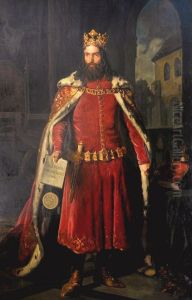Leopold Loffler Paintings
Leopold Loffler was a notable Polish painter, born in 1827 in Krakow, which was then part of the Austrian Empire and is now in Poland. He is particularly remembered for his genre scenes and portraits, capturing the essence of 19th-century life in Poland with a distinct flair and attention to detail. Loffler's work is characterized by its vivid depiction of the Polish peasantry, showcasing their customs, costumes, and daily life with a sympathetic and often romanticized lens.
Educated at the Krakow School of Fine Arts, Loffler furthered his studies abroad, which was a common practice among artists of his time seeking to refine their skills and gain broader exposure. He spent significant time in Vienna, Munich, and Paris, cities known for their vibrant art scenes and influential academic institutions. These experiences abroad enriched his artistic style, blending traditional Polish themes with broader European artistic trends of the 19th century.
Upon returning to Poland, Loffler became an influential figure in the local art community, contributing not just through his artworks but also through his role as a mentor to younger artists. His paintings were celebrated for their technical skill, particularly his use of color and light to evoke mood and atmosphere. Loffler's ability to tell stories through his art made his works popular among both Polish audiences and international collectors.
Despite his success, Loffler remained deeply connected to his Polish heritage, which continued to inspire his work throughout his career. He was an active participant in the cultural life of Krakow, engaging in various artistic societies and exhibitions. His contributions to the Polish art scene were recognized during his lifetime, and he was admired for his dedication to portraying the Polish identity through his art.
Leopold Loffler passed away in 1898, leaving behind a legacy that has continued to influence Polish art. His works are preserved in various collections and museums, serving as a testament to his skill and dedication to capturing the spirit of Poland in the 19th century. Through his paintings, Loffler provided a window into the life of the Polish peasantry, offering insight into their traditions and the beauty of everyday life, making him a cherished figure in the annals of Polish art history.
